Introduction
Immigrant-owned small businesses comprise 48% of New York City’s roughly 220,000 small businesses1. Immigrants employ nearly half a million New Yorkers2 and contribute $195 billion to the city’s gross domestic product (GDP) annually3. These businesses are anchors within their communities, particularly in immigrant-dense commercial corridors. They provide culturally relevant goods and services and a space for neighbors to convene.
Immigrant-owned small businesses are crucial to New York City’s economic and cultural vitality, and yet brick and mortar tenants currently face a number of challenges impeding their likelihood of survival. In past reports4, the Association for Neighborhood & Housing Development (ANHD) cited commercial warehousing, barriers to securing finance, and lack of governmental resources as threats to the wellbeing of all small businesses in the city. However, the particular needs of immigrant small businesses in neighborhoods have gone largely unexplored.
When immigrant neighborhood institutions vanish, jobs, community spaces, and affordable resources in low wealth communities of color also disappear. Commercial displacement becomes cultural displacement. ANHD, alongside our members Cooper Square Committee, Chhaya CDC, and Northwest Bronx Community & Clergy Coalition developed the Immigrant Cultural Corridors project (ICC) in order to gain a deeper understanding of the particular needs of immigrant small business owners across New York City.
The ICC Initiative sought to assess the needs of immigrant-dense commercial corridors and communities at varying stages of development: post-transition communities, transitioning communities, and stagnating corridors. Other criteria included emphasis on immigrant density and concentration of commercial units. The three surveyed neighborhoods represent an array of ethnic backgrounds, cultural histories, and streetscapes. Working with community partners in the Lower East Side, Jackson Heights, and Kingsbridge, we engaged and gathered together immigrant small business owners to identify and discuss the most pertinent issues threatening the small business community.

Methodology
Over a period of six months, the Immigrant Cultural Corridor Initiative collected 83 surveys, facilitated 12 focus groups, conducted 15 in depth one-on-one interviews with neighborhood business owners, and engaged a collective 90 individual immigrant small business owners across the Lower East Side and Chinatown, Jackson Heights, and Kingsbridge. The ICC Initiative defines immigrant-owned businesses as independently owned, non-franchised businesses with twenty or fewer employees operated by a foreign born or first generation New Yorker. This report identifies this population as lacking sufficient protections against displacement.
Surveys were distributed both electronically and physically in three languages: English, Spanish, and Mandarin. Focus groups and survey administration both included one-on-one translators when otherwise necessary.
Located at the community spaces provided by neighborhood partners ranging from nonprofit offices to well-known neighborhood restaurants, the focus groups provided a local meeting ground for business owners to interact with each other outside of merchant associations or business improvement districts, and in some cases meet each other for the first time. During each focus group, we facilitated a discussion around major themes including:
- Rent
- Lease negotiation
- Relationship to landlord
- Relationship to other business owners in the commercial corridor
- Access to capital
In order to provide small business owners with additional resources, we invited long time Chinatown financial assistance nonprofit Renaissance EDC to discuss alternative financing options for neighborhood small businesses.
Executive Summary
Key Findings Across Neighborhoods
At the completion of this initiative, a total of 12 focus groups were conducted, 83 surveys were collected and 90 individual immigrant small business owners were engaged across the Lower East Side and Chinatown, Kingsbridge, and Jackson Heights. Surveys were distributed both electronically and physically in three languages: English, Spanish, and Mandarin. Focus groups and survey administration both included one-on-one translators when otherwise necessary. Respondents spoke 13 different primary languages and hailed from 13 countries across 5 continents. Across neighborhoods and demographics, we identified major issues across all three neighborhoods: rent burden, tenant harassment, barriers to access capital, and fines and access to city resources.
Rising Rent Burden Hurts Businesses
- The price of commercial rent is overwhelmingly the greatest concern among survey respondents.
- 77% of all survey respondents stated that they are overburdened by their current rent. Currently in NYC, no rent caps exist for commercial tenants.
- Across the three neighborhoods, 82% of respondents ranked cost of rent in their top three concerns. This tells us that the struggle to pay rent is a universal challenge despite a neighborhood’s economic and demographic typology.
- 47% of surveyed businesses stated that had to raise their prices in order to pay rent, and 28% stated they had lay off employees. When independent businesses are forced to pay high rents, the economic opportunity in their surrounding community is directly impacted.
Without a Lease, Commercial Tenants Have Few Protections Against Harassment
- 19% of respondents reported they currently do not have a lease in their name. Without one, a small business exists on a month-to-month basis with next to no rights. A landlord can deny their commercial tenants basic essential services, such as clear pathway to the entrance or functioning infrastructure, or evict them with only 30 days’ notice.
- Despite most businesses possessing a commercial lease, 49% regarded the length of their lease and/or fear of lacking/losing a lease in their top three concerns.
- Of all the businesses owners engaged during this project, only 2 reported that they owned their commercial space.
- 40% of the respondents from across the three neighborhoods reported an instance of harassment on behalf of their landlord.
Secondary Considerations
Aside from the top three identified concerns, the following responses acknowledge other ongoing concerns for immigrant small business owners:
- Access to capital: 44% of survey respondents stated that they currently have no place to access additional capital for their businesses
- Red tape and fines: 49% ranked of survey respondents ranked “tickets, fines, permits, and inspections” in their top three concerns
- Access to translation services: 36% of survey respondents that the City did not provide enough resources in their language—a statistic to which a business owner in Chinatown responded, “only in hospitals do they provide enough translation.”
- Fear of retaliation based on immigration status: 25% claimed that they feel their immigration status influences their business in some way, while 21% said the same of the presence of ICE and Customs and Border Control.
Findings
Businesses have operated in their neighborhoods for an average of 13 years. The businesses employ an average of 4 workers and 56% of respondents live in the neighborhood in which their business operates. Survey respondents spoke 13 different primary languages and hailed from roughly 13 countries across 5 continents.
At the completion of this initiative, we identified four major issues across all three neighborhoods: rent burden, tenant harassment, barriers to access capital, and fines and access to city resources.
1. Rising Rent Burden Hurts Businesses
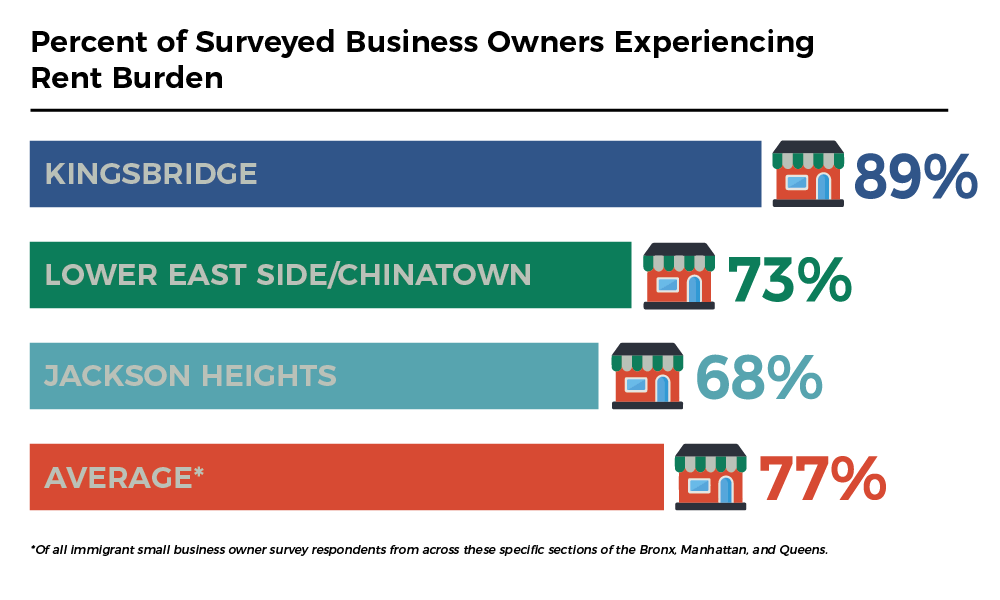 The price of commercial rent is overwhelmingly the greatest concern among survey respondents. Seventy-seven percent stated that they are overburdened by their current rent while 82% of respondents ranked cost of rent in their top three concerns. Currently in New York City, no rent caps exist for commercial tenants. A combination of increases in property value and real estate speculation in transitioning neighborhoods have caused prices in the commercial real estate market to soar. It is no longer uncommon to hear of longtime, beloved neighborhood institutions shutting their doors when their lease is up for renewal because they cannot withstand the incoming increase in rent.
The price of commercial rent is overwhelmingly the greatest concern among survey respondents. Seventy-seven percent stated that they are overburdened by their current rent while 82% of respondents ranked cost of rent in their top three concerns. Currently in New York City, no rent caps exist for commercial tenants. A combination of increases in property value and real estate speculation in transitioning neighborhoods have caused prices in the commercial real estate market to soar. It is no longer uncommon to hear of longtime, beloved neighborhood institutions shutting their doors when their lease is up for renewal because they cannot withstand the incoming increase in rent.
Since little information has been collected on commercial rents in the outer boroughs, it is difficult to assess trends in rent prices in the three neighborhoods. However, focus group participants identified rising property taxes as contributors to the rising cost of rent. Some leaseholders are bound by their leases to cover a certain percentage of the building’s total property tax — essentially a pass through in taxes from the landlord to the commercial tenant.
High Basic Operating Costs Prevent Businesses from Investing in Their Future
Increases in rent are not always proportionate to a small business’ generated income. In the age of e-commerce and chain stores, a significant portion of mom-and-pop retail has experienced a strain on business since the creation of online retail5. While it is reasonable to expect businesses to modernize and adapt to new trends, the high cost of rent makes it difficult for businesses to adapt to the changing demographic of their clientele, make necessary upgrades to their stores, or dedicate resources to advertising and e-commerce. For a small business owner struggling to pay rent, modernization is not the priority; the priority is to survive.
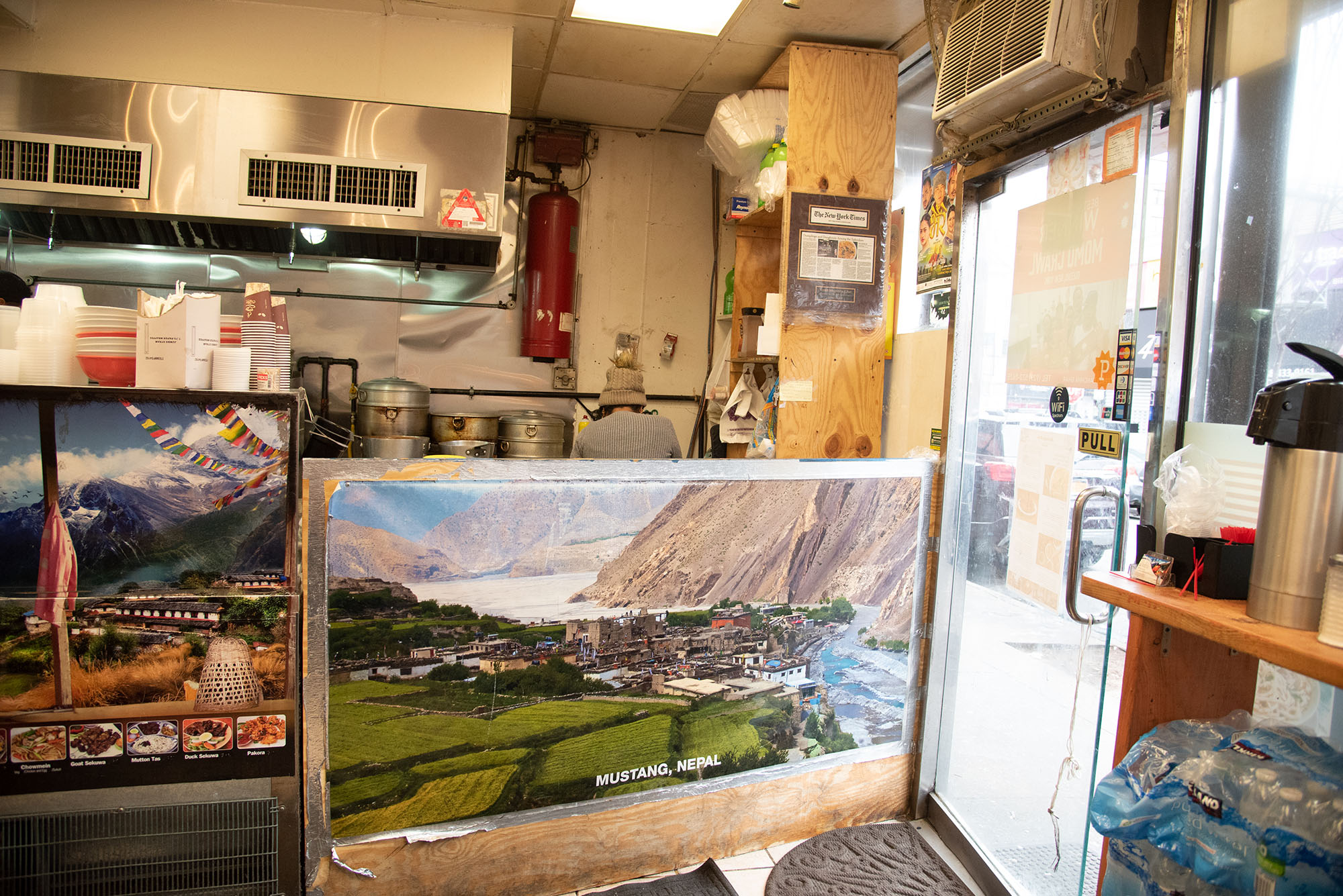
owner of Nepali Bhanchha Ghar in Jackson Heights.
If small businesses raise prices, they risk losing clientele. A neighborhood coffee shop in the East Village reported that after raising the price of their drinks by a “discrete” 25 cents, they noticed a drop of returning customers. Unfortunately, raising prices is a risk that small business owners must take in order to afford rent: 47% stated that they had to raise their prices in order to pay rent. Similarly, 28% stated that they had to lay off employees. Participating small business owners reported that they must keep their businesses open for longer hours without the necessary staff to alleviate the burden. As the owner of restaurant Nepali Bhanchha Ghar recalled in a focus group in Jackson Heights, “We work to pay, day by day.”
2. Commercial Tenants Have Few Protections Against Harassment
In addition to rising operating costs, immigrant small businesses face the threat of unscrupulous landlords. Forty percent of survey respondents reported an instance of harassment by their landlord. The term harassment is broad and may come in differing forms of severity. For the sake of this project, we define harassment as any way a landlord may deny a commercial tenant essential services pursuant to a lease agreement. This may include heat, electricity, hot water, or clear access to storage spaces.

Currently, there is only one law that explicitly provides commercial tenants legal protection from harassment. The Non-Residential Tenant Harassment law passed in 20166, while a major step forward in creating meaningful protections for commercial tenants, provides tenants the right to take a landlord to civil court. However, the onus lies on small business owners to take time away from day-to-day operations to bring their case to court, and it does not cover businesses without a lease nor provides legal services. Few financial resources exist to help small business owners cover the cost of litigation. Even if prosecuted, City Government has no role in ensuring harassment does not continue. As a result, the law lacks efficacy.
In addition to harassment by their landlord, 22% of respondents believe that the presence of U.S. Immigration and Customs Enforcement (ICE) and increased surveillance puts their business at risk. Immigrant small business owners remain vulnerable to these pressures without ways to advocate for the right to independently own and operate a business.
Without A Lease, Commercial Tenants Have Even Fewer Protections
 Nineteen percent of respondents reported they currently do not have a lease in their name — Kingsbridge has the lowest percentage of leaseholders at 68% while the Lower East Side/Chinatown has the highest at 93%. Businesses operating without a lease are at a higher risk of displacement. Without one, a small business exists on a month-to-month basis with next to no rights. A landlord can deny their commercial tenants basic amenities, such as a clear pathway to the entrance or functioning infrastructure, or evict them with only 30 days’ notice.
Nineteen percent of respondents reported they currently do not have a lease in their name — Kingsbridge has the lowest percentage of leaseholders at 68% while the Lower East Side/Chinatown has the highest at 93%. Businesses operating without a lease are at a higher risk of displacement. Without one, a small business exists on a month-to-month basis with next to no rights. A landlord can deny their commercial tenants basic amenities, such as a clear pathway to the entrance or functioning infrastructure, or evict them with only 30 days’ notice.
All but one of the lease-less businesses once held a lease for the same location, but their landlord refused to renegotiate. It is common practice for a landlord to refuse a lease renewal, even to a long term tenant. Fifty-six percent of respondents that cited an instance of harassment reported that their landlord refuses to issue or negotiate the terms of their lease. A month-to-month tenant is preferable to many landlords in markets experiencing rising rents; it creates flexibility for the landlord to bring in a new tenant who can afford higher rents, or even sell the building.
Forty-nine percent of businesses regarded the length of their lease and/or fear of losing a lease in their top three concerns. Of the 90 businesses owners engaged during this project, only 2 reported they own their commercial space. While a commercial lease may not guarantee a business’s success, a lease provides some security and rights for small businesses, particularly those in neighborhoods facing raising real estate speculation and the influx of a new, wealthier demographic. In a focus group, business owners in Chinatown reported they must decide between signing a long-term lease without certainty their business will be relevant in 10 years’ time, or a short-term lease that would leave them to pay an increased market rent at its expiration. In an interview, a business owner in the Lower East Side regarded the process of signing a lease in a gentrifying neighborhood as a “gamble.”
3. Traditional Financial Institutions Underserve Immigrant Small Businesses
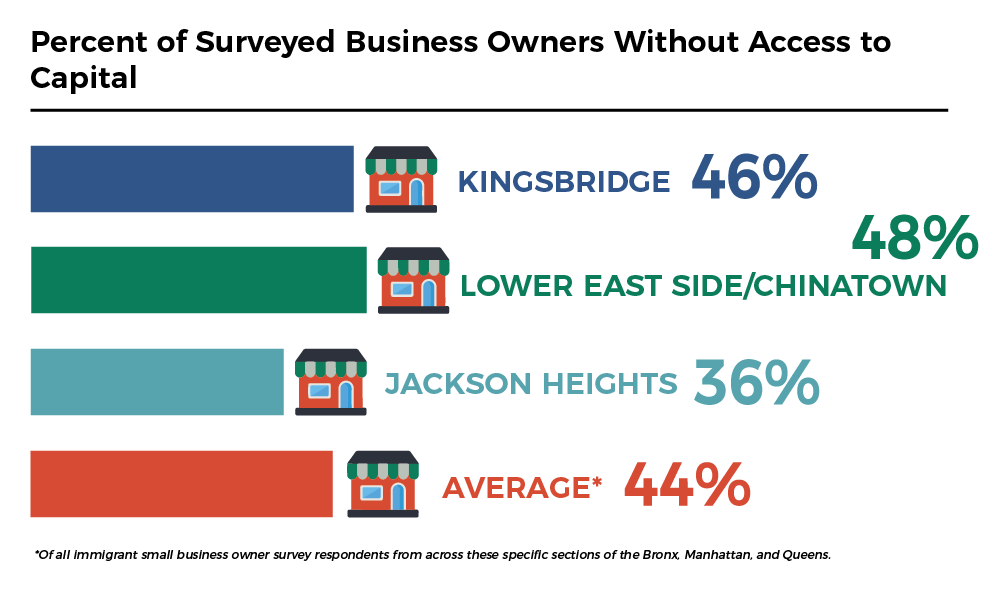 Forty-four percent of survey respondents stated that they currently cannot access additional capital for their businesses. Multiple focus group participants applied for small business or micro loans from traditional banks but were repeatedly denied. Immigrant small business owners face barriers in accessing loans from traditional financial institutions7. Many primarily deal in cash, do not have the capacity to keep detailed records and books, or may have complications in their immigration status that impacts their ability to access loans. After she was denied a loan from a traditional bank, the owner of W&E Income Tax Multiservices remarked, “I feel that banks should look at the whole situation that is happening right now. I’m going to serve a community. I’m going to be here for a good amount of time. They need to look at the whole trajectory of how small businesses are interacting with the community, the ins and outs.”
Forty-four percent of survey respondents stated that they currently cannot access additional capital for their businesses. Multiple focus group participants applied for small business or micro loans from traditional banks but were repeatedly denied. Immigrant small business owners face barriers in accessing loans from traditional financial institutions7. Many primarily deal in cash, do not have the capacity to keep detailed records and books, or may have complications in their immigration status that impacts their ability to access loans. After she was denied a loan from a traditional bank, the owner of W&E Income Tax Multiservices remarked, “I feel that banks should look at the whole situation that is happening right now. I’m going to serve a community. I’m going to be here for a good amount of time. They need to look at the whole trajectory of how small businesses are interacting with the community, the ins and outs.”
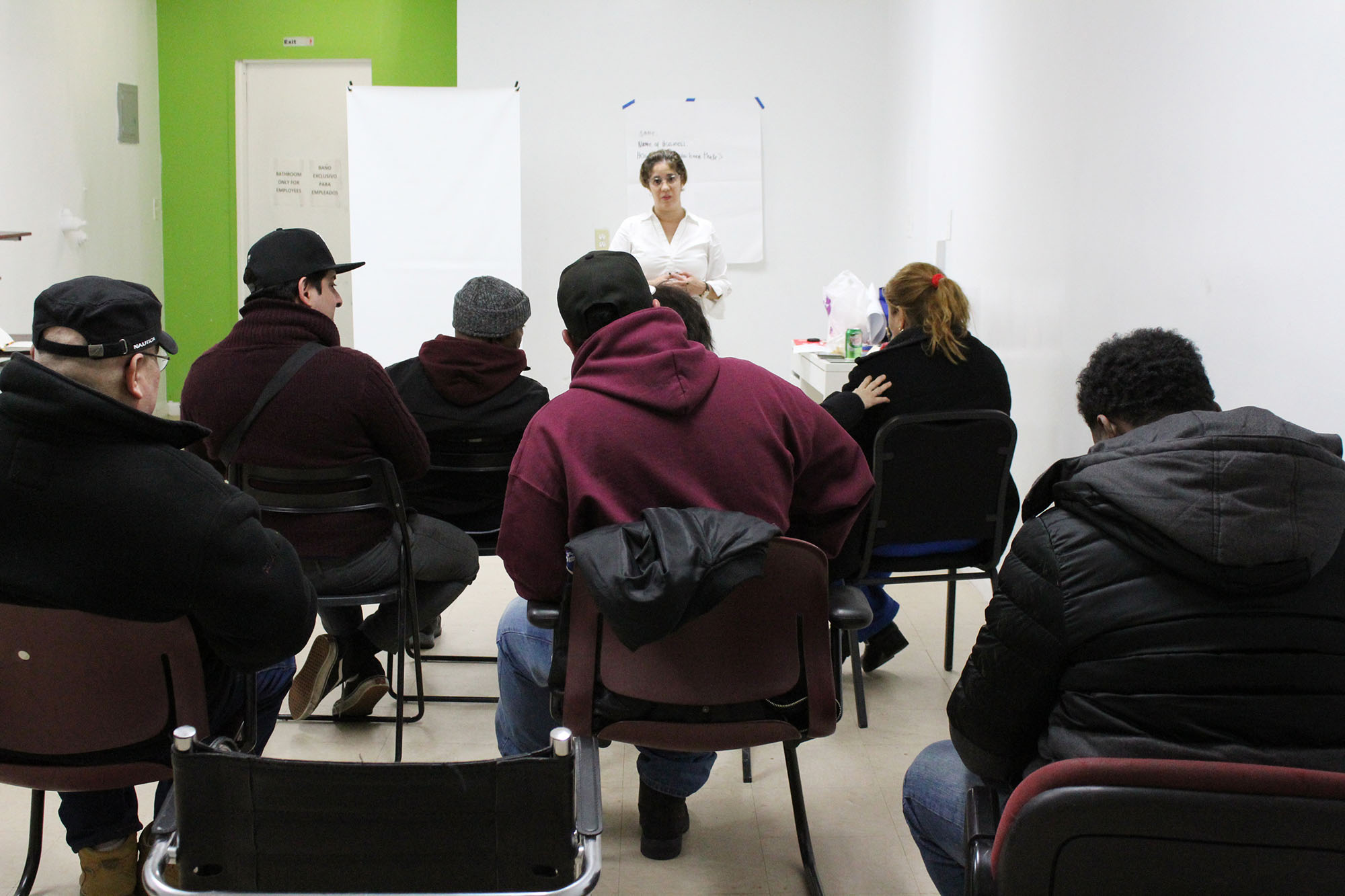
said Wendy, owner of W&E Income Tax Multiservices in Kingsbride. ”
I’m going to serve a community. I’m going to be here for a good amount of time.
They need to look at the whole trajectory of how small businesses are interacting
with the community, the ins and outs.”
In the absence of traditional financing options, immigrant small businesses owners turn to untraditional and unregulated community based resources, such as lending circles, or to loans from informal networks of family and friends.
4. Red Tape Disrupts Business and Stifles Growth
Forty-nine percent of survey respondents ranked “tickets, fines, permits, and inspections” in their top three concerns. Throughout interviews, food service providers in particular reported a contentious relationship with city agencies — the 2015 Mayor’s report Small Business First states, “A restaurant opening in New York City may have to file applications, make payments, undergo reviews, obtain approvals, get inspections, and receive licenses and permits from up to eight city agencies before it even opens its doors for business.”8 Twenty percent of survey respondents claim that the NYPD and city agencies put their businesses at risk of displacement. In the Lower East Side, the owner of Tai Thai restaurant retold stories of inspectors from the Department of Health coming into her restaurant’s kitchen without announcing who they were or showing her their badge. A few avenues east, another food service provider whose immigrant mother first opened their restaurant in 1970 proclaimed, “We don’t sell $70 a plate; we sell $10 plates, but the prices of the violations are still the same.”
Existing City Resources Lack in Exposure, Efficacy, And Accessibility
Thirty-six percent of survey respondents stated that the City does not provide enough resources in their language. According to a Chinatown business owner, “Only in hospitals do they provide enough translation.” During focus groups, business owners expressed a desire for more accessible information about city resources. Very few knew of the services or resources offered through the Department of Small Business Services (SBS) or any of its affiliated programs.

A longtime business owner on the Lower East Side reported that in moments of crisis, after Sandy and 9/11, he sought help through the City’s recovery grant programs but encountered negative experiences with overburdened city staff. He stated, “If you need something, especially from [the] government, [they don’t] help unless you keep bothering them…otherwise you are like dirt, like nothing, like nobody. Especially small businesses like us, nobody cares.”

Neighborhood Stories
The Lower East Side and Chinatown
The Lower East Side and Chinatown are post-transition communities, already experiencing the full force of premium rents and a mostly new consumer base demanding products and services alternative to the desires of neighborhoods’ previous demographic. These communities are having difficulties maintaining businesses new and old. Rapid increases in rent and a changing demographic base require older businesses to modernize, adopt promotional efforts, or diversify their product base. New businesses must begin with a higher rate of upfront capital as rents continue to peak.
While home to historic and culturally distinct shopping districts among Chinese, Latino, and Eastern European communities, the neighborhoods now also cater to a new consumer base of arts, high-end retail, nightlife, and tourism. Despite these changes, 34.5% of the Lower East Side and Chinatown residents are foreign born9.
Longtime Lower East Side merchants remarked on the changing demographic of their neighborhood. The owner of City Luggage, an Orchard Street retail institution of 35 years, observed increased commercial vacancies and decreased foot traffic. He recalled the neighborhood of his past, “Fifteen years ago, the Lower East Side was packed with people. Orchard Street [was] a lot like Times Square… Now look at it, empty. You know why? [Mom and pop] stores are all gone.”
A 2017 report by ANHD found a 3% loss of businesses in the Lower East Side and Chinatown since 201110. However, the neighborhoods received an average of 1,891 small business loans, as compared to the citywide average of 1,623 in 2017. In other words, while businesses in Chinatown and the Lower East Side are closing at higher rate than almost every other neighborhood in the city, new businesses are consistently taking their places. While New York City lacks data on small business longevity, surveyed immigrant small businesses in the Lower East Side/Chinatown have been in operation for an average of 13 years.
Seventy-three percent of the immigrant business owners surveyed in the Lower East Side and Chinatown stated they are overburdened by their current rent. One retail shop owner said in order to continue to pay rent after sales fell over a period of years, he decided to extend his hours of operation: “Before I opened 10 to 6, everybody was open 10 to 6. Now I open 8 o’clock in the morning till 10 o’clock at night.”

Lower East Side. “I work for the insurance. Just make it and then pay.
It’s shameless. [It’s] like that all the time, more than five years.”
Business owners reported they must make such changes to their business models in order to adapt to higher rents — laying off employees, raising prices, and extending business hours. Fifty-two percent of respondents reported they had to raise prices in order to make rent. This impacts the livelihood of their neighborhoods. For longtime residents who already face rising rents, an increase in the cost of basic goods and services creates additional financial pressure and intensifies their chance of displacement. “I work for the landlord,” the same business owner remarked. “I work for the insurance. Just make it and then pay. It’s shameless. [It’s] like that all the time, more than five years.”
Forty-eight percent of those surveyed reported a lack of access to capital. Many feel that they have been shut out of traditional financing options, both from financial institutions and city resources. The owner of Nick and Son’s Clothing Co. remarked, “[The City] is not looking out for the small people. They [are] looking out for the people who got good credit…. If you qualify [for financing from the city] then it’s good but you don’t need it. What do I need it for? Because then I can go to the bank and get it from Chase.”
Jackson Heights
Jackson Heights, Queens is a community undergoing rapid transition. Transitioning communities need to develop a commercial corridor comprised of both older, established businesses and new businesses. In order for a healthy mix of new and old businesses to survive, both must market to a diverse consumer base of longtime residents and newcomers. Older businesses must modernize in order to attract a new clientele, while new businesses need to educate themselves on the broader community’s needs and norms. These are neighborhoods where property values are rising quickly, so commercial tenants must be prepared to negotiate fair rents.
While the neighborhood is home to many different ethnic groups, this report’s catchment area is home to mostly South Asian businesses. The neighborhood is in a process of shifting from catering to an Indian and Pakistani demographic to a newer Nepali, Tibetan, and Bangladeshi majority. As a transitioning community, Jackson Heights is also facing a rapid influx of non-immigrant residents. However, 60% of Jackson Heights residents are foreign born11.

Jackson Heights community. “When [the Indian community] was here, they were very young and
their parents were alive in India. As 30, 40 years passed, they are here no longer there
so their necessity of buying saris in bulk has diminished… so we lost those customers.
But at the same time, we now service the other [Bangladeshi] communities.”
In Jackson Heights, businesses have been in operation for an average of 9 years, the shortest average length of operation of any surveyed neighborhood. This may be due to market pressures, along with a shifting neighborhood demographic. Many different ethnic groups have called the neighborhood home, yet small business owners acknowledged the recent change in their customer base. The manager of India Sari Palace, a long-time staple of the community, stated, “Generations have changed. When [the Indian community] was here, they were very young and their parents were alive in India. As 30, 40 years passed, they are here no longer there so their necessity of buying saris in bulk has diminished…so we lost those customers. But at the same time, we now service the other [Bangladeshi] communities.”
Red tape and bureaucracy are a major issue for small businesses in Jackson Heights. Eighty-one percent of business owners ranked tickets and fines as a top concern. Immigrant small business owners in Jackson Heights face the added challenge of language barriers. Forty-two percent of survey respondents stated they do not believe the City provides enough resources in their household language. Immigration is constantly at the forefront of many small business owners, 25% of survey respondents in Jackson Heights believe that their immigration status negatively influences their business.
Commercial tenants in Jackson Heights are particularly vulnerable to landlord harassment. The restaurant owner of Nepali Bhanchha Ghar recalled that when she and her landlord could not come to an agreement on a lease negotiation, the landlord repeatedly retaliated with antagonistic measures. In one instance, he reduced the power in her restaurant so her industrial size refrigerator could no longer run well enough to preserve her food. In response to her a story, another business owner noted, “a residential landlord wouldn’t get away with that.”
Kingsbridge
The commercial corridor in the Kingsbridge area of the Bronx is approaching stagnation. Small businesses in stagnating corridors experience growing pressure from landlords but idling or decreasing business. These businesses face a decrease in consumers and foot traffic, along with a decline in new businesses. However, there is strong sense of community among longtime businesses and their patrons.
Kingsbridge has been a predominantly Dominican enclave, and a new wave of West African, Vietnamese, and Cambodian immigration has led to a shift in neighborhood dynamics, 43.9% of Kingsbridge residents are foreign born12. Kingsbridge’s immigrant-owned businesses are particularly at risk of displacement. A staggering 89% of businesses reported feeling overburdened by their current rent. Further, Kingsbridge businesses reported the lowest average number of employees — 2.5, and is the community where the most businesses were forced to lay off employees in order to pay rent. Thirty-eight percent of Kingsbridge businesses had to fire workers in order to remain operational.
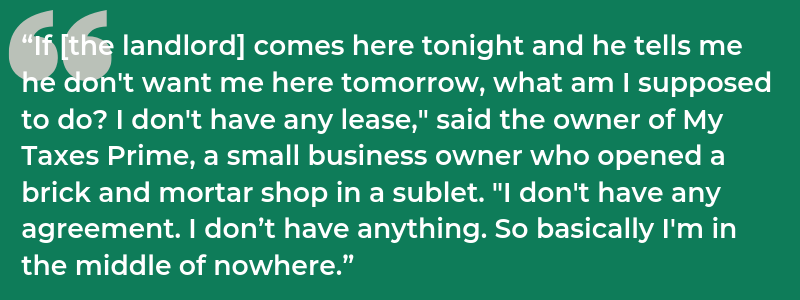
Kingsbridge is also among the neighborhoods that received the fewest small business loans in 2017— 430 loans compared to the citywide average of 1,62313. Focus group participants universally agreed that small business loans are crucial for a small business to remain operational. However, 46% of immigrant business owners report they do not have a place to access capital for their business.
Fifty-seven percent of respondents reported an instance of landlord harassment, the most of the three surveyed neighborhoods. Focus group participants revealed a pattern of harassment specific to Kingsbridge small businesses — a landlord denying or delaying a lease renewal. Thirty-two percent of immigrant small business owners in Kingsbridge do not currently have a lease. The owner of Kings Gift Shop, a local retailer of 28 years, reported multiple attempts to communicate with his landlord in order to get his lease renewed. “We speak to them and they keep us on hold. He says he’ll think about it but he never gets back to us. [He] says the same thing to the neighbors. So, we gave up on that. Right now, we’re month-by-month. Really, we gave up.”
Kingsbridge business owners reported they must sublease space, ranging from a desk to a segmented room, within their shops in order to make rent. This stifles retailers from expanding their businesses as the lack of space cuts into storage and show space. The owner of My Taxes Prime, a small business owner who opened a brick and mortar shop in a sublet commented, “If [the landlord] comes here tonight and he tells me he don’t want me here tomorrow, what am I supposed to do? I don’t have any lease. I don’t have any agreement. I don’t have anything. So basically I’m in the middle of nowhere.”
The redevelopment of the nearby Kingsbridge Armory, slated to become the world’s largest ice-skating center14, has led to increased speculation and rising rents in nearby buildings. A Community Benefits Agreement accompanies the proposal for redevelopment and includes a $250,000 grant fund for local businesses and a Small Business Incubator within the premises. Despite these resources, focus group participants revealed that their shared landlord intends to evict them and transform their commercial spaces into a hotel.
Conclusions & Recommendations
Immigrant small businesses are cornerstones of New York City’s neighborhoods and communities. They provide culturally relevant goods and services, localized economic opportunity, and add to the City’s vibrancy and street life. Despite the central role immigrant small businesses play in New York’s economy and culture, they face many roadblocks in reaching even baseline stability. Operating a small business is already risky; 20% of small businesses fail within a year and only a third of small businesses survive for ten years or longer15. The obstacles faced by immigrant small businesses are compounded by harassment based on immigration status, very high costs of rent, and a lack of access to services and resources due to language barriers.
Based on survey results, focus group conversations, and one on interviews with small business owners, we propose the following policy recommendations the City and State may adopt to relieve some of the pressures that particularly impact small business owners. Some of these recommendations will help change the landscape for all commercial tenants. When immigrant small businesses are lifted up, all small businesses are lifted up.
- Define and penalize non-residential tenant harassment to reflect the various forms of harassment faced by immigrant small businesses. This includes harassment based on immigration status, failure to provide essential services, and a landlord’s refusal to provide a lease or engage in lease negotiations.
- Bolster small business resources that provide legal and lease assistance, such as the Commercial Lease Assistance program, to help immigrant small business owners navigate and negotiate the lease renewal process.
- Expand options for financing geared toward helping existing businesses stay in operation. In particular, it would be advantageous to focus on institutionalizing access to culturally relevant financial assistance such as lending circles. The City should also consider providing low interest loans and grants with the specific goal of helping existing small business build out or upgrade their space.
- Expand regulations of the commercial rental market in light of increased speculation. The City and State should consider penalizing landlords who warehouse commercial property and keep it vacant in hopes of attracting a tenant who can pay higher rents. Vacant properties decrease foot traffic, which adversely impacts existing small businesses in commercial corridors.
- Coordinate across city and state agencies in order to both reduce fines and red tape, and offer relevant services across agencies. The City and State should coordinate and expand translation services for all offered resources.
New York City’s commercial tenants have gone too long without having the necessary rights and protections to safely and fairly operate small businesses. Immigrant-owned small businesses, while disproportionately at risk of displacement, embody the city’s historic, economic, and cultural roots. Their preservation is essential towards building a safe and equitable economic landscape for all of New York.
Endnotes
1.Association for Neighborhood Housing and Development, “Taking Care of Business: Understanding Commercial Displacement in NYC,” December 2017.
2.New York Immigration Coalition, “Blueprint for Immigrant New York,” November 2017.
3.Mayor’s Office of Immigrant Affairs, “State of Our Immigrant City: Annual Report,” March 2018.
4.Association for Neighborhood Housing and Development, “Taking Care of Business: Understanding Commercial Displacement in NYC,” December 2017.
5.Institute for Local Self-Reliance, “Statement on Amazon’s Small Business Impact Report,” https://ilsr.org/amazons-small-business-report-may-2018/, May 2018.
6.New York City Bar, https://www.nycbar.org/get-legal-help/article/landlord-tenant/commercial-tenant-harassment-lawyer/, October 2017.
7.Association for Neighborhood Housing and Development, “Better Small Business Lending Requires Better Data,” September 2017.
8.Small Business First Report, https://www1.nyc.gov/assets/smallbizfirst/downloads/pdf/small-business-first-report.pdf, February 2015.
9.American Community Survey, 2017
10.Association for Neighborhood Housing and Development, “Taking Care of Business: Understanding Commercial Displacement in NYC,” December 2017.
11.American Community Survey, 2017.
12.American Community Survey, 2017.
13.Association for Neighborhood Housing and Development, “Taking Care of Business: Understanding Commercial Displacement in NYC,” December 2017.
14.City and State “Long-awaited Kingsbridge National Ice Center nears deal,” https://www.cityandstateny.com/articles/policy/policy/kingsbridge-national-ice-center-nears-deal.html, September 2018.
15.U.S. Small Business Administration Office of Advocacy https://www.sba.gov/sites/default/files/advocacy/Frequently-Asked-Questions-Small-Business-2018.pdf,
August 2018.